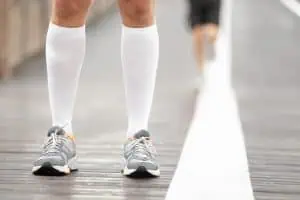
Medically reviewed by: Luke Maj, MD
When you think of compression socks, you might picture the thick, ugly garments your grandma used to wear. But today’s compression socks and compression stockings aren’t just for elderly adults with bad circulation. In fact, even athletes wear them.
Whether you’re a man or a woman, if you stand for long periods or you have tired, heavy legs due to a common vein condition called chronic venous insufficiency, you may notice a world of difference after wearing compression socks (knee high) or stockings (thigh or waist high) during the day.
“I’ve been wearing compression socks for 10 years because they make my legs feel so much better,” said Luke Maj, MD, an interventional radiologist and head of the Water’s Edge Dermatology Vein Center. “When I take them off after a long day of standing at work, my legs feel like I just woke up in the morning.”
What do compression socks do?
Compression socks and stockings, which fit snugly, gently squeeze the legs, compressing the veins near the surface. This helps prevent fluid buildup and keeps blood moving toward the heart rather than pooling in the legs. Pooled blood swells the veins, puts extra pressure on their valves and can lead to vein disease and symptoms such as leg tiredness, aching and cramps.
Benefits of compression socks and stockings
Compression socks and stockings can make a huge difference in how your legs feel and can even help stave off future vein issues. Here are some of their benefits.
Improving blood flow when you sit or stand for long periods
Lack of movement impairs blood circulation and causes blood to pool. Wearing compression socks when you’re on your feet all day or you’re sitting during a long flight or car ride can help keep your legs comfortable. Wearing them when you sit for long periods also lowers the risk of developing a potentially fatal blood clot in your legs, a condition called deep vein thrombosis or DVT.
Easing leg cramps
Chronic venous insufficiency (CVI) is a common cause of leg cramps at night. In CVI, the one-way valves in the veins that are supposed to prevent blood from flowing the wrong way (toward the feet instead of the heart) are weak or damaged. As a result, blood becomes trapped in the legs. People who have any degree of CVI, whether they know it or not, may experience painful leg cramps at night.
Wearing compression socks during the day often helps. Dr. Maj noted, “Ninety percent of my patients with leg cramping say they feel better when they try wearing compression stockings.”
Calming restless legs
In some people with restless leg syndrome, which involves a deeply uncomfortable urge to move the legs, CVI is largely to blame. Wearing compression socks can help. If it does, you’d likely be a good candidate for leg vein treatment, according to Dr. Maj.
Preventing vein problems
Since pooled blood can lead to CVI and varicose veins over time, stopping the blood from pooling can help stave off these conditions or slow their progression. Compression socks may also help prevent spider veins from forming.
Relieving varicose vein symptoms
If the one-way valves in your veins are weakened or damaged, you might develop rope-like, twisted varicose veins. Wearing compression socks or stockings helps relieve common symptoms of varicose veins, such as pain and heaviness in the legs.
Speeding exercise recovery
Compression socks, stockings and other garments have become popular among athletes. Studies suggest compression wear may support faster muscle recovery and reduce post-exertion soreness. Some athletes say compression socks help prevent shin splints.
Minimizing dizziness on standing
Compression stockings may be recommended if you have orthostatic hypotension. People with this condition feel dizzy as soon as they stand up after sitting or lying down.
Reducing leg swelling
Leg swelling (edema) is a symptom of many medical conditions, including diabetes, kidney disease and heart failure. Wearing compression stockings helps move fluid out of the legs and reduce swelling. Maternity compression stockings can help ease leg swelling during pregnancy.
Reducing plantar fasciitis pain
Plantar fasciitis causes stabbing pain on the bottom of the foot under the heel due to inflammation of ligaments that run along the bottom of the foot. Compression socks that squeeze the middle of the foot help relieve the pain by supporting the arch.
Supporting recovery from vein treatments
If you undergo treatment for varicose veins or spider veins, your provider will likely prescribe compression stockings of a specific strength to help speed recovery and reduce the risk of bruising and blood clots.
Finding the best compression socks for you
When choosing compression socks or stockings, the main factors to consider are size, strength and height. Ask your vein specialist for a recommendation rather than picking something off the shelf. Choosing the right size and strength (level of compression) is important for avoiding side effects of wearing compression stockings.
“Poorly fitting compression socks and stockings can bruise your legs and irritate the skin, increasing the risk of infection,” said Dr. Maj. “And if they’re too tight, they can make blood circulation in the legs worse.”
People who require a higher level of compression will need a prescription from their doctor. Prescription compression socks and stockings are typically recommended when treating a medical condition such as DVT.
Your doctor can also tell you what style of compression gear is best for you. For example, short compression socks are often the right choice if you have plantar fasciitis. Knee-high compression socks are more likely to be recommended for fluid buildup in the lower legs. People with orthostatic hypotension should wear waist-high or thigh-high compression stockings.
How to put on compression socks
Because they are designed to fit snugly, compression socks and stockings can be challenging to put on. Ask your doctor for guidance on technique. Wearing rubber gloves can improve your grip on the stocking, or you can use a stocking donner. These devices are steel frames that hold the stocking open for you. Some have hand grips to help you put your leg in.
How long should you wear compression socks?
Your doctor may tell you to put on the stockings when you wake up in the morning, while you’re still in bed. He or she will also advise you how long to wear them.
Should you wear compression socks to bed? “Almost no one should be wearing them at night,” said Dr. Maj. “You want free blood flow at night with no compression. Sleeping flat is also very important. It’s fine to use a pillow, but make sure your legs are at the same level as the heart or higher.” That means no sleeping in recliners.
Wondering where to buy compression socks and stockings? You can purchase them through Water’s Edge Dermatology, at your local pharmacy and on websites such as Amazon.
Written by: Jessica Brown, a health and science writer/editor based in Nanuet, New York. She has written for Prevention magazine, jnj.com, BCRF.org, and many other outlets.





